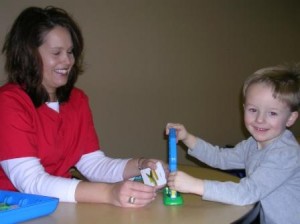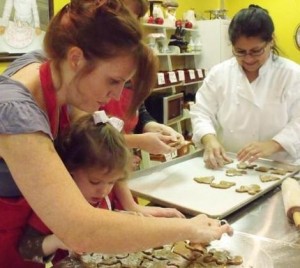Guest Post! We’re always looking for clever new ways to keep education—especially speech education—fresh and fun at home. So when we stumbled across Time 4 Speech’s brand new subscription-based “speech activities in a box” service, we called right away to get the scoop. Amber Fisher describes how she got started.
How to Prepare for Speech Therapy Home Visits
Speech Therapy TechniquesPerhaps you’ve already determined that you’d like to have your child seen by a speech pathologist and have had some of your initial questions answered. Many times your child’s speech therapy services can be delivered in the comfort and convenience of your own home. Especially for younger children (i.e. up to age 5), being “on their own turf” can really help foster rapport between your child and the clinician and make your child feel maximally comfortable as he or she works on something that may be somewhat challenging. This brief post is dedicated to providing parents with a few tips for maximizing the effectiveness of speech therapy home visits. The better prepared and knowledgeable you can be as you start the process of your home-based speech therapy, the more likely it is that your child will achieve his or her speech or language learning goals.
Helping my Child with Speech Therapy: Private or School-Based
Parents' CornerIn a recent blog post, “I Think my Child Needs Speech Therapy – Now What?”, I outlined the process of securing speech and language therapy services for your child. But let’s say your child has just begun or has been in therapy for some time? What then? Do you find yourself wondering, “how should I be helping my child with speech therapy?” This post is dedicated to providing tips for parents on how to maximize the services they are already receiving. Whether your child is receiving school-based or private therapy, there are many things a parent can do to empower themselves and ultimately, to make therapy more efficient.
[Photo: skyseeker, CC]
How to Teach the “R” Sound
Speech Therapy TechniquesThe “R” Sound
The “r” sound can be especially challenging to pronounce. It’s a voiced sound, produced by the vibration of the vocal cords. The reason why this particular sound is so difficult to master is that it can be correctly pronounced 8 different ways, depending on the letters with which it is combined. If you factor in the positioning of all of the variations of an “r” at the beginning, middle, or end of a word, you end up with 21 total variations.
Encouraging Communication in the Home
Speech Therapy TechniquesWhile your child learns new communication skills with his speech-language pathologist (SLP), you can also work on your own communication skills. Learning more effective means of communicating with your speech disordered or delayed child can help him progress more quickly. Take advantage of everyday activities to encourage language. Create a communication-friendly environment for your child by using techniques that stimulate verbal and nonverbal communication. Always discuss home-based speech therapy with your child’s SLP. The SLP can offer advice and suggest educational activities that are tailored to your child’s needs.





